Intercultural Storytelling – A Storified Chronicle
NEST Gallery
This is a gallery of images collected during NEST (November Experimental Story Telling), Fall 2016. Participants were invited to share an image that represented a relationship or partnership in their lives. Captions offer additional context for their selection by each participant. During NEST conversations, participants explored one another’s photos in a layered sequence of inquiry and interaction. This discovery process begins with each participant working with someone else’s photo. They are each invited to offer a surface level description of what can be seen in the photo based on the visual elements and subject matter. The others in the group listen without interruption. After each image is described, there is another round of conversation that invites participants to offer possible interpretations as to why they think the image was shared as a representation of a partnership or relationship. After this, pairs within the group get together to tell the fuller story of the image they shared to one another. They are invited to listen carefully to their partner’s story as they will then return to the group with the task of re-telling the story of the image as if it were their own. This first person storytelling was inspired by the work of Narrative 4.
Reflections on The Imaginative Leap – Intercultural Storytelling & Empathy
For one minute on Thursday, October 27, I was not myself. Instead, I was Amy.
Before I was born, my family had a lot of suggestions about what my parents should name me. Because my birthday is December 7, my veteran grandfather suggested I be named Pearl Harbor. On the other side of the family, a lack of boys led to the suggestion to name me Buford (Buffy, for short) to carry on the family name. Thankfully, my parents didn’t choose either of those names and named me Amy after one of their friends. I did, however, end up loving Buffy the Vampire Slayer.
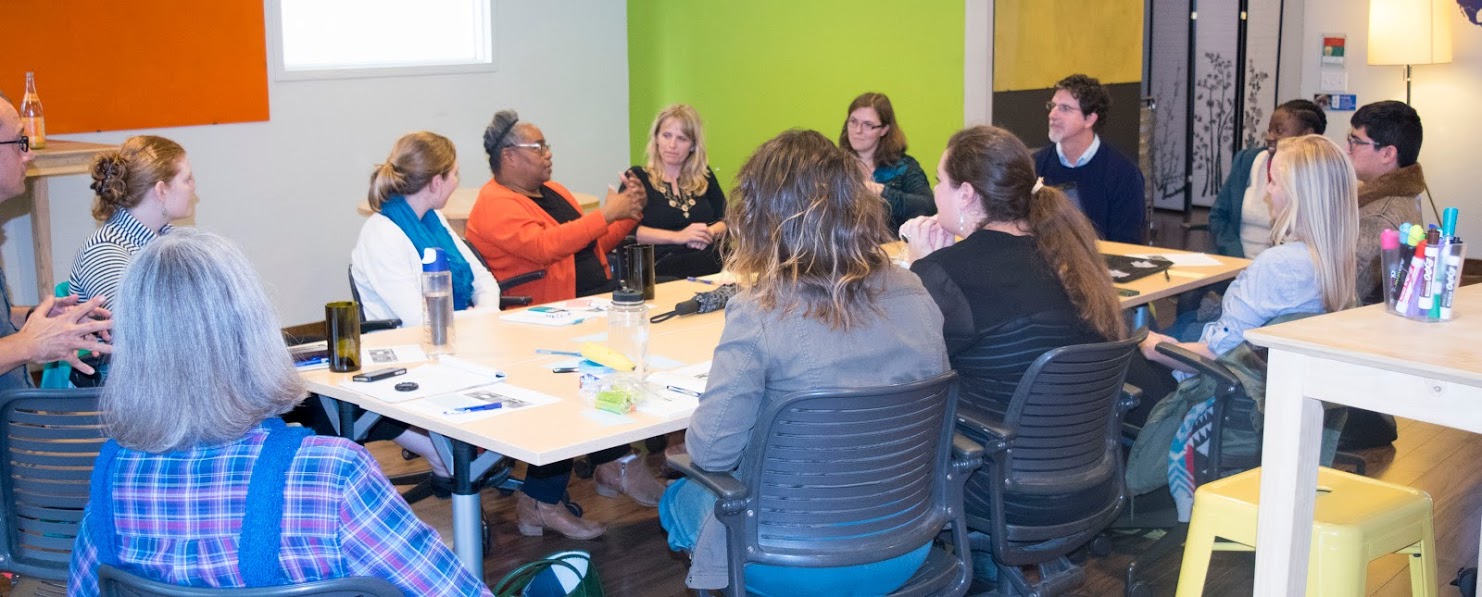 When I returned to being Lucy, I learned that the point of becoming someone else for just two minutes was to understand empathy as it relates to storytelling. A version of this exercise was originally created by Narrative 4, a storytelling organization whose mission is to “Build a community of empathetic global citizens who improve the world through an exchange of personal narratives.” During one particular application of this activity, Narrative 4 partnered with two high schools in New York by pairing students from each of the schools together to share each other’s stories. You can read the piece about their interaction, The Tale of Two Schools, in the New York Times Magazine.
When I returned to being Lucy, I learned that the point of becoming someone else for just two minutes was to understand empathy as it relates to storytelling. A version of this exercise was originally created by Narrative 4, a storytelling organization whose mission is to “Build a community of empathetic global citizens who improve the world through an exchange of personal narratives.” During one particular application of this activity, Narrative 4 partnered with two high schools in New York by pairing students from each of the schools together to share each other’s stories. You can read the piece about their interaction, The Tale of Two Schools, in the New York Times Magazine.
What surprised many of the storytellers at the Imaginative Leap: Digital Storytelling & Empathy Workshop were the details their partner (story listener) chose to focus on when retelling the stories of their name. A passing comment or minute detail on the part of the storyteller in some cases became the main focus of the story listener’s retelling. People selectively choosing certain details and not others when they recount stories illuminates an important point that extends beyond this naming activity. As a group we suddenly realized that these interpretations and reinterpretations happen every day, in every interaction. This forced us to ask, “How much of what I say is actually being synthesized by others?”
This question has been rattling around my brain for about a week now, yet still has me seriously questioning almost every encounter I have. What are people really taking away from what I say? How am I differently shaping what I say based on the person I’m talking to? Unfortunately, I have no way of knowing, and that’s what makes empathy so difficult to understand. We can try as hard as we can to put ourselves in someone else’s shoes, but we will still be ourselves in their shoes.
Danny Pavitt made this dilemma clear in his IDSP Project storytelling fellowship project submission from the 2015-2016 school year. After the adapted Narrative 4 storytelling game, workshop participants watched Danny’s video, “A Day in Her Life.” The video shows the ins and outs of daily life for a Mapuche (indigenous group of Chile) tribe leader, with selected images, audio, and video recorded from the day she was visited by MIIS students. After watching the video [together with other workshop participants] and observing some discussion, I revealed to the group that I had also been on the Chile trip with Danny. My experience with the woman featured in his video was quite different from his, and the fact that neither Danny nor the leader were present at the workshop was the biggest lesson in empathy of all. Who was I to give my perspective on someone else’s story about another someone else?
It’s a question, just like the one about how our own perspectives shape what we hear, that is still marinating in my grey matter. Having now attended two of the four #IDSP17 workshops, I’m convinced that the only way to answer these questions is to continue to explore other stories and the empathy that accompanies them. Luckily, the December #IDSP17 happening will present opportunities for further conversations like these. Join us at the DLC on December 8 from 12:15-1:45 and keep your eyes peeled for more information. Hope to see you there!
Reflections on Building Community Partnerships One Story at a Time
One bowl of spaghetti. Two forks.

My first interpretation of this six word story was Disney’s Lady and the Tramp, but I struggled with seeing how the dogs would use the forks. Another interpretation was that someone went to grab a spoon and fork out of the drawer, but they only had forks. A third interpretation was a date night at home, with two people cutely sharing one bowl.
It wasn’t until Dr. Netta Avineri proposed an alternative interpretation of the story as a metaphor for poverty (based on a novel perspective that a new student had shared with her) that the group considered the bowl of spaghetti from a new perspective. Unlike a cute date night, two people sharing one bowl of food means that there isn’t enough food to go around. This icebreaker put the participants of the “Building Community Partnerships One Story at a Time” workshop in the right mindset for the hour and a half adventure they were about to take.
Dr. Avineri is TESOL/TFL Assistant Professor and Chair of the Intercultural Competence Committee. DLC Director Bob Cole and Dr. Avineri are also the co-founders of the Intercultural Digital Storytelling Project (http://sites.miis.edu/idsp/). Her workshop on Thursday was the first in a series of three happenings that are a part of the Nested Stories project. These workshops, hosted in collaboration with the DLC, are meant to explore the role of interculturality and storytelling on-campus, and are part of the Envisioning Middlebury Community Initiated Conversations initiative. We plan to explore the Intercultural Digital Storytelling Project through reflection, community discussion, and a variety of presentations. During the workshop, participants from all corners of MIIS discussed the ways in which perspective and empathy are cornerstones to building mutually beneficial and meaningful partnerships.
We explored the importance of empathy by watching an RSA animate video about the power of Outrospection, in which Roman Krznaric explained why we need empathy in our lives.
“Empathy is something that can make you a more creative thinker, improve your relationships, and can create the human bonds that make life worth living”.
Krznaric went on to explain two types of empathy, affective and cognitive. Affective empathy is a shared emotional response, while cognitive empathy is an understanding of someone else’s worldview. Both of these empathies are essential when it comes to building partnerships, but it was the cognitive empathy that resonated most with workshop participants. We noticed the tie between perspective and cognitive empathy, and then had a discussion on the difficulty of changing perspectives. Netta noted the new literature on critical empathy, which highlights that no matter how hard we try to put ourselves in someone else’s shoes and to abandon our own thoughts and biases, we will never be completely able to see the world through eyes that are not our own. While this prospect may at first seem disheartening, it was designed to highlight the hard work involved in true empathy. Participants were hopeful that with the continued practice of empathy, changing perspectives may get a little bit easier to manage. Netta also highlighted the role of “nests”, those groups and communities in which cultivation, growth, and evolution are facilitated. This lies at the heart of “nested interculturality” (Avineri, 2015), the ability to seamlessly move across cultural boundaries, which shapes this fall’s Nested Stories enterprise.
Netta noted that storytelling and story-listening can be the technology for empathy. As the workshop came to an end, participants had the opportunity to watch a digital story from 2015 IDSP fellow and 2016 senior fellow Katie Barthelow, and were encouraged to apply the concepts of perspective, empathy, and partnership to their discussion.
What resulted was a thoughtful analysis of the ways that Katie applied perspective and empathy in her informal partnership with the basketball players she met in Rwanda, and the ways that mornings became her comfort zone during an immersive learning trip in which so much else was novel.
We are thrilled with the turnout and execution of the first workshop and are excited to host the next session Thursday, October 27.
IDSP 2016 Fellowship Showcase
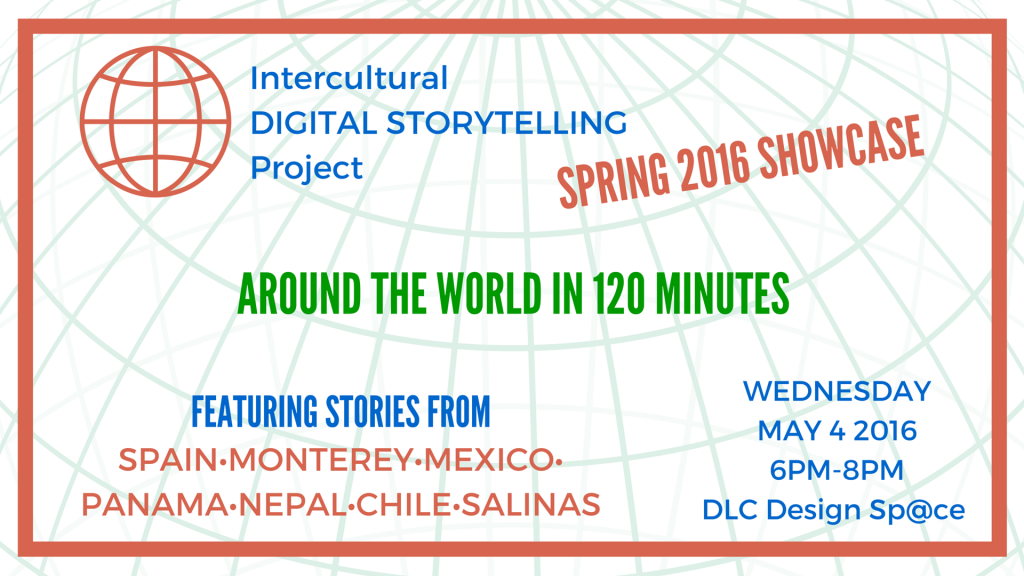 The art of story has been around for centuries because it’s a fundamental way we make meaning as humans. It’s the way we reflect, share, and learn both individually and collectively. Digital tools have made this process easier and more accessible, adding dimensions to the storytelling process and avenues through which to share locally and globally.
The art of story has been around for centuries because it’s a fundamental way we make meaning as humans. It’s the way we reflect, share, and learn both individually and collectively. Digital tools have made this process easier and more accessible, adding dimensions to the storytelling process and avenues through which to share locally and globally.
The six #IDSP16 Fellows invite you to share in their experiences around the world through a screening of their digital stories in a community showcase on May 4th, 2016 from 6-8pm at the DLC Design Space. This interactive evening will offer a glimpse into storytelling and the fellowship process where reflection, immersion, inductive research, peer mentorship and digital media merge into story. Come celebrate with us, experience some amazing stories, and interact with your peers. Light snacks will be served.
The Intercultur al Digital Storytelling Project, also known as #IDSP, was designed for students at the Middlebury Institute of International Studies at Monterey (MIIS) involved in immersive learning activities affiliated with their academic experiences. The IDSP Fellowship experience was designed to around 5 key competencies: immersive learning, inductive research, peer mentorship, reflection, and digital media. The year-long timeline supports fellows in by guiding them through the development of these skills.
al Digital Storytelling Project, also known as #IDSP, was designed for students at the Middlebury Institute of International Studies at Monterey (MIIS) involved in immersive learning activities affiliated with their academic experiences. The IDSP Fellowship experience was designed to around 5 key competencies: immersive learning, inductive research, peer mentorship, reflection, and digital media. The year-long timeline supports fellows in by guiding them through the development of these skills.
IDSP hosts J-Term Storytelling Night at the DLC
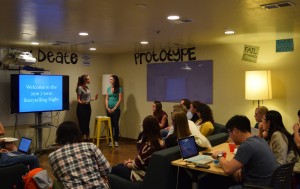
On Tuesday February 16th, Katie Barthelow and Anna Santos of the Intercultural Digital Storytelling Project (IDSP) hosted an open-mic style, storytelling night at the DLC. Students who participated in immersive learning experiences were invited to share their funny, happy, serious, goofy, or insightful stories. Current and perspective students, faculty, and staff from different departments at MIIS attended the event.
Students performed stories about their experiences doing fieldwork in Nepal and Peru, as well as stories about independent projects and activities.
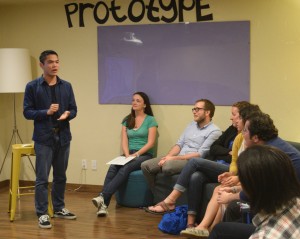
Immersive learning can involve a lot of uncomfortable moments, insightful revelations, culture shock, and personal change. Processing those moments through storytelling is not only beneficial for the storyteller but is also beneficial in creating a community with greater sharing, support, and communication.
The J-Term Storytelling Night is part of an initiative to facilitate greater communication and sharing of the unique student projects and experiences of MIIS students.
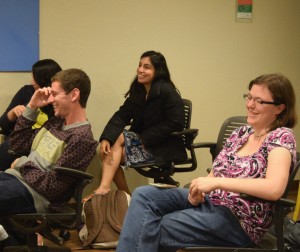 The Intercultural Digital Storytelling Project (IDSP) began as an opportunity for students to participate in a fellowship around intercultural immersive learning experiences. The digital storytelling fellowship is the flagship program of IDSP, which currently has 7 fellows who are in the process of creating digital stories about their J-term experiences this Spring. One of IDSP’s Spring initiatives is to expand storytelling opportunities throughout the MIIS campus and beyond.
The Intercultural Digital Storytelling Project (IDSP) began as an opportunity for students to participate in a fellowship around intercultural immersive learning experiences. The digital storytelling fellowship is the flagship program of IDSP, which currently has 7 fellows who are in the process of creating digital stories about their J-term experiences this Spring. One of IDSP’s Spring initiatives is to expand storytelling opportunities throughout the MIIS campus and beyond.
J-term Storytelling Night
Come join us for a night of storytelling about J-term experiences. This will be an informal, open-mic inspired night where everyone is welcome to share. Sign up to tell a story the night of the event, and feel free to bring visual aids (photos, videos, etc) on a jump-drive to help tell your story. We hope to see you there!
IDSP Update: South Africa
By Taylor Robb-McCord; IEP student and IDSP16 fellow
For as long as I can remember, my dad has been the one herding our family into the car and insisting on getting to the airport at least two hours before any flight. If you’re flying out of a major airport, you might end up at the airport three or four hours before your flight. He takes no risks.
I know he’s right, but for years I have struggled getting to the airport on time. If you know me, you will know that I struggle getting anywhere on time. After numerous missed flights (and even showing up at the wrong airport to check-in), I have tried my best to be on time for flights, mainly out of the sheer fear of having to call my dad and tell him, once again, I missed my flight.
I was flying from Zambia back to my parent’s house in South Africa, and taking my dad’s advice, I was not going to be late and I did my math numerous times. My flight was at 6:30pm. Okay, two hours early means arrive at 4:30pm. An hour to the airport to ensure I’m not late from traffic means I leave at 3:30pm. Perfect. Foolproof.
I set off that afternoon with my friend Valerie for a leisurely afternoon before heading to the airport. In typical Taylor style, my trip to the airport unfolded like this:
12:00 – Pedicures and mango smoothies! Taylor convinces Valerie to drive 45 minutes in the opposite direction of the airport for lunch.
1:30 – We arrive at the restaurant and settle in for lunch.
3:15 – Still at lunch. We both start thinking we should start making our way to the airport.
3:20 – Taylor MUST have dessert and coffee. So we order brownies, apple pie and cappuccinos.
3:50 – Start making our way to the car through the gift shop. Taylor MUST buy gifts.
4:15 – We get in the car. GPS estimates it’s a 30-minute drive to the airport and we start to follow the blue trac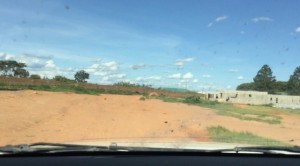 k.
k.
4:30 – We hit a dead end. Fudge buckets. Turn around.
4:40 – Back on the main road.
4:50 – Make a few turns and the paved road turns to dirt. The GPS says we are correct, so we carry on.
5:15 – The dirt road turns into a narrow road and eventually the car can’t fit. Valerie performs the most amazing reverse driving and backs up a ¼ mile of narrow road, dodging people, bricks, chickens, and wire fences.
5:20 – Back on the “main” dirt road. Phew. Assure myself that arriving at the airport before 5:45pm for an international flight will be fine.
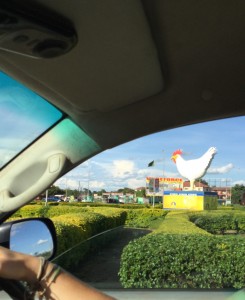 5:30 – Valerie screams “CHICKEN!” and I instantly think we will have to pay someone for driving over their chicken. But then I see ahead of us, a giant chicken statue in the middle of a roundabout. The last landmark before the airport.
5:30 – Valerie screams “CHICKEN!” and I instantly think we will have to pay someone for driving over their chicken. But then I see ahead of us, a giant chicken statue in the middle of a roundabout. The last landmark before the airport.
5:45 – We pull up to the airport, say our goodbyes and I speed walk (really speed walk) to the ticketing agent.
6:00 – I make it through security and to my gate. Only slightly concerned that the security agent didn’t once look at the x-ray machine screen and maintained eye contact with me the entire time. What could I have smuggled in my luggage?
2016 resolution – just be on time and no, you do not need dessert and coffee. I take that back, yes you do. Always.
IDSP Update: Salinas
By Anita Joshi; MPA student and IDSP16 fellow
Eating Locally, Thinking Globally
The month of January has been full of surprises of all types. I have been working with the organic farmers in Salinas to try and build more sustainability into the local food systems that most of us often take for granted. The farmers of course, being on the front lines, are fighting the battle from dawn till dusk. I call it a battle because that’s my impression of it at times, given how the many internal and external variables in small-holder farming function. Since I’ve started working with the farmers and produce distributers, I’ve learned that our food systems have become more complicated and less transparent over the past few generations. My grandparents were consumers in a totally different system than what it is now.
I started working with these farmers after they had gone through the farm worker-to-farmer program at the Agricultural and Land-Based Training Association. My idea was to develop a plan to help connect people that produce food with the people that consume the food. This was an alternative to the corporate tyranny that most farmers have to deal with because our food system has evolved to prioritize convenience for the consumer instead of social justice within the system. So I started working to create a produce co-op and identify ways to help connect the farmers to new market opportunities. My vision was that this would benefit everyone, from improving farmers’ access to markets to giving consumers access to the freshest, vine-ripened (as opposed to shelf-ripened) produce. One farmer, Mr. Gallardo, originally from Oaxaca, grew strawberries whose intense flavors reminded me of the old Skittles commercial; “Taste the rainbow!” (because I’m pretty sure rainbows taste like the sweetest organic produce known to man.) With this level of quality, one would imagine the price would be sky-high. The reality was at the season’s peak they sold for barely $1 per pound. Not nearly enough to even pay the workers or pay for the land, water, and other inputs.
After many conversations and “A-ha!” moments, I learned that one can never underestimate how strong of a pull convenience has for consumers. This is understandable; who doesn’t like convenience? But it seemed to me that even consumers who wanted out of this system didn’t have a lot of choices, or even the awareness of- or connections with- the local food producers. Yet, this was the modern food chain, and I was trying to dismantle it one organic tomato at a time. The corporate super markets have held on to the status quo with a clenched fist. Even when the system makes no sense to anyone.
A couple months after I first became acquainted with the farmers, I realized the upshot of all that I had been doing and trying to figure out. I had had a frustrating past few weeks with my consumer networks falling apart and realizing no amount of social media posting would change corporate hegemony, I vented to myself: “People! You’re rejecting the sweetest Salinas Valley Sun-riped rainbow heirlooms?! Why don’t you all just go to SaveMart and buy cardboard-flavored tomatoes!” Then one day, while walking downtown, someone I know on the street yells “Hey Anita! You got any organic tomatoes yet?” Surprised, I inwardly jump a little jump-for-joy at the sound of someone asking me about organic produce. “Soon!” I say. “I hear February or March, when the rain lets up maybe.” And I relish in the notion of someone seriously thinking locally and seasonally, instead of only thinking about Trader Joes. Maybe the beginning of a ripple effect. Or not. It was just one person. But that’s where it all starts.

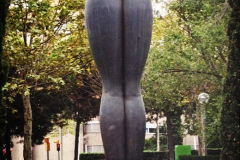
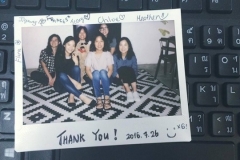

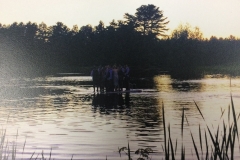




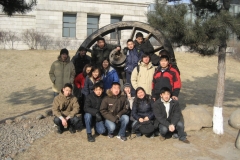
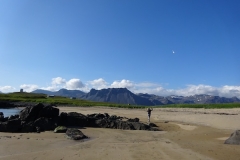

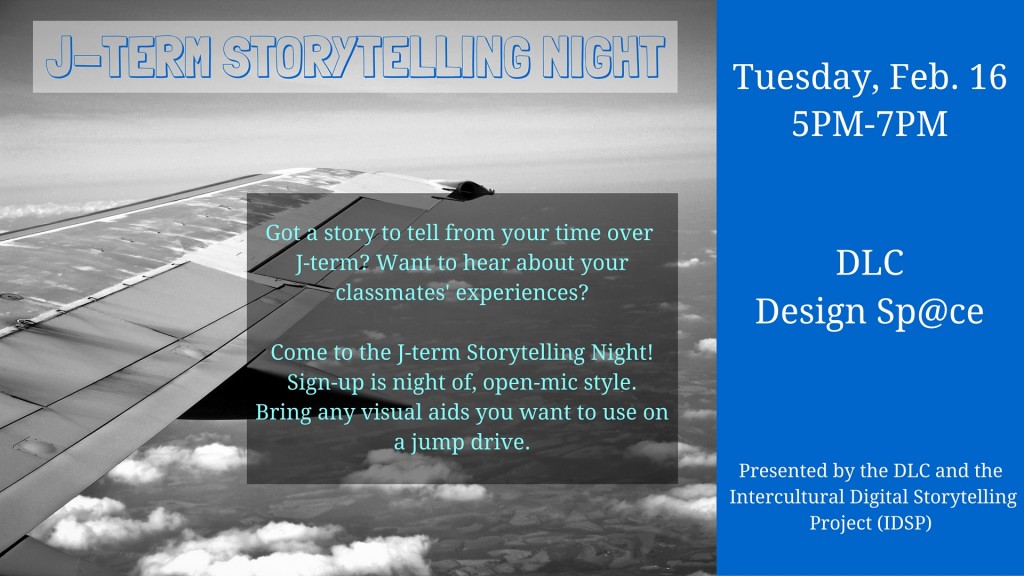


You must be logged in to post a comment.